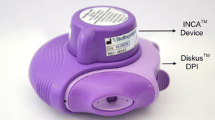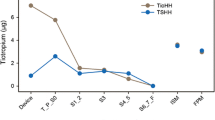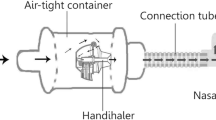Abstract
Purpose
The relative lung bioavailability of salbutamol sulfate particles produced using supercritical fluids (SEDS™) and delivered by dry powder inhaler (DPI) was compared with the performance of a conventional micronized drug DPI using the same device design (Clickhaler™, Innovata Biomed).
Materials and Methods
Twelve healthy volunteers and 11 mild asthmatic patients completed separate four-way randomised cross-over studies, assessing the relative bioavailability of salbutamol sulfate (urinary excretion method), formulated as SEDS™ particles (three batches) and micronized particles (Asmasal™ inhaler, UCB Pharma Ltd). Post-treatment improvements in patient lung function were assessed by measuring FEV1. Physicochemical evaluation of the three SEDS™ batches revealed inter-batch differences in particle size and shape.
Results
There was no significant difference in the relative lung bioavailability of salbutamol and its bronchodilator response between the best performing SEDS™ formulation and the Asmasal™ inhaler in volunteers and patients, respectively. SEDS™ salbutamol sulfate showing wafer like morphology gave greater fine particle dose, relative lung bioavailability and enhanced bronchodilation compared to other SEDS™ batches containing elongated particles.
Conclusions
Active Pharmaceutical Ingredient (API) manufactured using supercritical fluids and delivered by DPI can provide similar lung bioavailability and clinical effect to the conventional micronized commercial product. Product performance is however notably influenced by inter-batch differences in particle characteristics.



Similar content being viewed by others
Abbreviations
- ACI:
-
Andersen cascade impactor
- ANOVA:
-
Analysis of variance
- API:
-
Active pharmaceutical ingredient
- DPI (s):
-
Dry powder inhaler(s)
- FEV1 :
-
Forced expiratory volume in 1 s
- FPD:
-
Fine particle dose
- GSD:
-
Geometric standard deviation
- HPLC:
-
High performance liquid chromatography
- MMAD:
-
Mass median aerodynamic diameter
- RSD:
-
Relative standard deviation
- SD:
-
Standard deviation
- SEDS™:
-
Solution enhanced dispersion by supercritical fluids
- SEM:
-
Scanning electron microscopy
- TOF:
-
Time of flight
References
C. Varsha, and R. Dalby. Novel system to investigate the effects of inhaled volume and rates of rise in simulated inspiratory airflow on fine particle output from a dry powder inhaler. Pharm. Sci. [online computer file] 4(2): (2002).
M. R. Feddah, K. F. Brown, E. M. Gipps, and N. M. Davies. In vitro characterisation of metered dose inhaler versus dry powder inhaler glucocorticoid products: influence of inspiratory flow rates. J. Pharm. Pharmaceut. Sci. 3(3):317–324 (2000).
A. H. de Boer, P. Hagedoorn, D. Gjaltema, J. Goede, K. D. Kussendrager, and H. W. Frijink. Air classifier technology (ACT) in dry powder inhalation Part 2. The effect of lactose carrier surface properties on the drug-to-carrier interaction in adhesive mixtures for inhalation. Int. J. Pharm. 260(2):201–216 (2003).
F. Podczeck. The influence of particle size distribution and surface roughness of carrier particles on the in vitro properties of dry powder inhalations. Aerosol Sci. Tech. 31:301–321 (1999).
G. Buckton, A. Choularton, A. E. Beezer, and S. M. Chatham. The effect of comminution technique on the surface energy of a powder. Int. J. Pharm. 47(1–3):121–128 (1988).
G. H. Ward, and R. K. Schultz. Process induced crystallinity changes in albuterol sulfate and its effect on powder physical stability. Pharm. Res. 12(5):773–779 (1995).
H. Steckel, and H. G. Brandes. A novel spray-drying technique to produce low density particles for pulmonary delivery. Int. J. Pharm. 278:187–195 (2004).
J. M. Lobo, H. Schiavone, S. Palakodaty, P. York, A. Clark, and S. T. Tzannis. SCF-Engineered powders for delivery of budesonide from passive DPI devices. J. Pharm. Sci. 94(10):2276–2288 (2005).
H. Schiavone, S. Palakodaty, A. Clark, P. York, and S. T. Tzannis. Evaluation of SCF-Engineered particle-based lactose blends in passive dry powder inhalers. Int. J. Pharm. 281:55–66 (2004).
R. O. Williams III, J. Brown, and J. Liu. Influence of micronization method on the performance of a suspension triamcinolone acetonide pressurized metered-dose inhaler formulation. Pharm. Dev. Technol. 4(2):167–169 (1999).
A. J. Hickey, and T. B. Martonen. Behaviour of hygroscopic pharmaceutical aerosols and the influence of hydrophobic additives. Pharm. Res. 10(1):1–7 (1993).
P. H. Hirst, G. R. Pitcairn, J. G. Weers, T. E. Tarara, A. Clark, L. A. Dellamary, G. Hall, J. Shorr, and S. P. Newman. In vivo lung deposition of hollow porous particles from a pressurized metered dose inhaler. Pharm. Res. 19(3):258–264 (2002).
H. Lahrib, G. P. Martin, C. Marriot, and D. Prime. The influence of carrier and drug morphology on drug delivery from dry powder formulations. Int. J. Pharm. 257(1–2):283–296 (2003).
R. M. Auty, K. Brown, M. G. Neale, and P. D. Snashall. Respiratory tract deposition of sodium cromoglycate is highly dependent upon technique of inhalation using the spinhaler. Br. J. Dis. Chest. 81:371–380 (1987).
S. Pederson, and G. Stefferson. Fenoterol powder inhaler technique in children: influence of inspiratory flow rate and breath-holding. Eur. J. Respir. Dis. 68:201–214 (1986).
M. Parry-Billings, R. N. Boyes, L. M. Clisby, P. Braithwaite, S. Williams, and A. E. Harper. Design, development and performance of a novel multidose dry powder inhaler. Pharm. Technol. 23:70–81 (1999).
J. Barrowcliffe, P. McGlynn, S. Tickle, F. Sandbank, and T. Wong. The In vitro evaluation of a novel multi-dose dry powder inhaler. Drug Delivery Lungs 7:82–85 (1996).
M. Parry-Billings, C. Birrell, L. Oldham, and C. O’Callaghan. Inspiration flow rate through a dry powder inhaler (Clickhaler™) in children with asthma. Pediatr. Pulmonol. 35:220–226 (2003).
N. Nantel, and M. T. Newhouse. Inspiratory flow rates through a novel dry powder inhaler (Clickhaler) in pediatric patients with Asthma. J. Aerosol Med. 12(2):55–58 (1999).
M. Hindle, and H. Chrystyn. Determination of the relative bioavailability of salbutamol to the lung following inhalation. Br. J. Clin. Pharmacol. 34:311–315 (1992).
M Hindle, and P. R. Byron. Dose emissions from marketed dry powder inhalers. Int. J. Pharm. 116:169–177 (1995).
V. L. Silkstone, H. S. Tomlinson, S. A. Corlett, and H. Chrystyn. Relative bioavailability of salbutamol to the lung following inhalation when administration is prolonged. Br. J. Clin. Pharm. 50(3):281–284 (2000).
B. J. Lipworth, and D. J. Clark. Effect of airway calibre on lung delivery of nebulised salbutamol. Thorax 52:1036–1039 (1997).
O. S. Usmani, M. F. Biddiscombe, and P. J. Barnes. Regional lung deposition and bronchodilator response as a function of beta2-agonist particle size. Am. J. Resp. Crit. Care Med. 172:1497–1504 (2005).
J. Nazir, D. J. Barlow, M. J. Lawrence, C. J. Richardson, and I. Shrubb. Artificial neural network prediction of aerosol deposition in human lungs. Pharm. Res. 19(8):1130–1136 (2002).
J. Nazir, M. J. Lawrence, and I. Shrubb. Artificial neural network prediction of the patterns of deposition of polydisperse aerosols within human lungs. J. Pharm. Sci. 94(9):1986–1997 (2005).
B. O. Stuart. Deposition of inhaled aerosols. Arch. Intern. Med. 131:60–73 (1973).
J. C. Feeley, P. York, B. S. Sumby, and H. Dicks. Determination of surface properties and flow characteristics of salbutamol sulfate before and after micronization. Int. J. Pharm. 172:89–96 (1998).
F. Podczeck, and Y. Miah. The influence of particle size and shape on the angle of internal friction and the flow factor of unlubricated and lubricated powders. Int. J. Pharm. 144(2):187–194 (1996).
Acknowledgements
The authors would like to thank the Engineering and Physical Sciences Research Council (EPSRC) in the UK for funding this research jointly through a case award with GlaxoSmithKline (GSK). We would also like to thank DMV, GSK, Nektar Therapeutics, ML Laboratories and Medeva Pharmaceutical Ltd for supply of materials and componentry.
Author information
Authors and Affiliations
Corresponding author
Rights and permissions
About this article
Cite this article
Richardson, C.H., de Matas, M., Hosker, H. et al. Determination of the Relative Bioavailability of Salbutamol to the Lungs Following Inhalation from Dry Powder Inhaler Formulations Containing Drug Substance Manufactured by Supercritical Fluids and Micronization. Pharm Res 24, 2008–2017 (2007). https://doi.org/10.1007/s11095-007-9328-y
Received:
Accepted:
Published:
Issue Date:
DOI: https://doi.org/10.1007/s11095-007-9328-y




